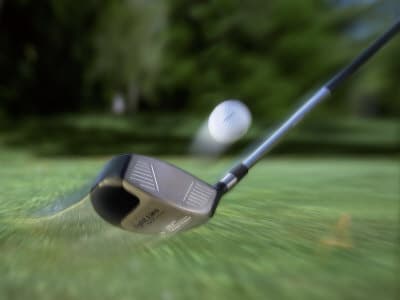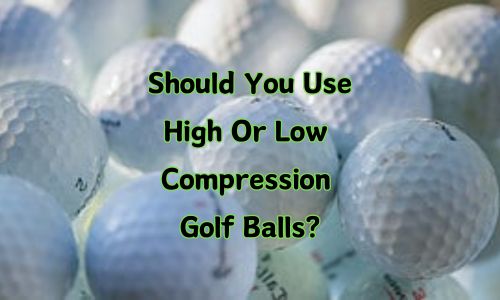Should you use high or low compression golf balls?
While all golf balls may look the same, there are vast differences in their structure and performances.
When golfers talk about ball compression, they’re discussing how much a golf ball deforms under the impact of a club. The concept isn’t just technical jargon; it directly impacts how the ball behaves with every stroke.
Golf balls with low compression will respond more readily to a golfer with a slower swing speed and high compression balls are more suitable to those with higher swing speeds. This fundamental difference affects the flight, distance, and feel of a ball during play.
Why does this matter for you? The right compression ensures that you’re getting maximum efficiency out of your swings. It directly influences your ability to control the ball and ultimately your scorecard.
It’s not just about having a good swing; it’s about having the right tools that complement your style of play.
You can find more information here on the best golf balls for women.
Your choice of golf ball compression should cater to the strength and speed of your swing — a personalized approach that could make all the difference to your game.
High Compression vs. Low Compression: Features and Characteristics.
Golf balls might look similar to the untrained eye, but their construction is a finely-tuned science.
Compression ratings for golf balls fall between 30 and 120, with the higher number requiring a much harder swing.
When it comes to the features and characteristics of high versus low compression balls, the contrast starts at the core.
High compression balls typically have a denser core that requires a faster swing to compress.
On the other hand, low compression balls have a softer core, making them more compressible for those of us with slower swings.
Speaking of energy transfer, this is where compression gets practical.

A high compression ball, when struck correctly, can lead to greater ball speed, spin and potentially more distance. Thus, players with higher swing speeds can take full advantage of the energy return.
In contrast, a low compression ball will achieve better results for those with slower swings and will lead to improved ball speed.
Feel and control are subjective aspects of a golf ball but they’re crucial for fine-tuning your game.
High compression balls tend to offer a firmer feel and will give experienced players more control over their shots. Low compression balls have a softer feel, which is likely to be forgiving on miss-hits and offer better control for those with a lighter touch.
Lastly, durability and response to weather conditions can also be tied to a ball’s compression. High compression balls can be less affected by cold weather. Therefore, they maintain their performance characteristics better than low compression balls in the same conditions. Regardless, when choosing between the two, consider your typical playing environment alongside your play style.
Matching the Ball to the Golfer: Swing Speed & Performance
It’s essential to understand swing speed in golf because it directly impacts the ball’s performance.
Swing speed is the rate at which the golf club head is moving at impact and is usually measured in miles per hour (mph). Golfers with faster swing speeds can compress the ball more, which results in greater distance.
There is a definite difference between the swing speeds of men and women. Here, we are not talking about PGA and LPGA players, but about those of us who might be described as “weekend golfers.”
Most men will swing the golf club at around 80-90 mph. Whereas, most women’s swing speeds will fall within the range of 60-70 mph.
So, as you can see, women, on average, have lower swing speeds when compared to men. This disparity isn’t just a blanket statement but is backed by ample data collected from player statistics and performance analytics.
Of course, this is also directly related to the fact that men have more upper-body strength than us girls. Therefore, their swings are certainly going to be faster than ours.
As a result, the majority of female golfers will benefit from using lower compression golf balls. These compress more easily and can travel further for someone with a gentler swing.
To gauge your own swing speed without professional equipment, you can compare the average distances you achieve with your clubs to standardized swing speed charts available online or at golf shops. Remember, this method won’t be as accurate as a professional assessment, but it can offer you a general idea.
Anecdotal evidence and data from golf clinics show that when golfers switch to a golf ball that complements their swing speed—whether it’s high or low compression—their performance improves.
This improvement manifests as better distance control, a more desirable ball flight, a decent score and overall game enjoyment.
Selecting Your Ideal Golf Ball: Taking Action on the Tee.
Choosing the right golf ball can revolutionize your game. It’s not just about aesthetics or brand names; it’s about PERFORMANCE and FEEL. Your swing speed is critical, but it’s only one piece of a larger puzzle.
Here’s my tip for you: Test several golf balls with varying compressions. You’ll QUICKLY notice differences in distance, flight stability, and how they feel when you strike them.
Trust your own experience above marketing hype.
Looking beyond compression is essential. Yes, it’s fundamental, but so are factors like price and personal preference. Sometimes a less expensive ball with the right compression for your swing can out-perform pricier options.
Remember, like any sports equipment, golf balls are SUBJECTIVE. What works for a friend with a similar swing speed might not work for you. Take advantage of Clubs and driving ranges that offer demo days or fittings.
Final Thoughts On Should You Use High Or Low Compression Golf Balls.
Finally, stay informed. Read reviews, talk to experts, and most importantly, get out on the course and play.
Your perfect golf ball match enhances your game, brings more joy in play, and maybe, just maybe, shaves off those frustrating extra strokes.
Here are the things to think about when choosing your perfect golf ball.
- Understand your own golf swing – where does it fall in the range of fast or slow.
- If you don’t know, use a swing speed chart to give you guidance.
- When choosing a golf ball, make sure that it is not too hard or soft for your swing.
- Try out a number of different golf balls to see which one best suits your play.
Above all, have fun, play well and enjoy the game.


